Digging Into A 50-Year-Old Controversy: Dana Creative Arts Center
Take a stroll around campus and one building stands out distinctly from the surrounding landscape: the Dana Creative Arts Center. The building was designed by Paul Rudolph and has been controversial since the original unveiling of its design.
A 1964 New York Times article reported that Charles A. Dana, the main funder and namesake, objected to the design. During the meeting to unveil the design, he reportedly asked: “Why have that bridge? Walking is good exercise for the students.”
For current students, “not enough walking” is not a common concern expressed in response to Dana. The controversy has changed but is still alive and well. While some students have fond memories of their artistic experiences in the space, others emphasize the cold and dark interior and the way the building does not match with the rest of campus architecture.
“I don’t really ever go there because I’m not involved with any activities that are hosted there (besides seeing shows my friends are in at the theater) so I don’t have any emotional connections, but I’ve heard friends call it ‘a disgustingly brutalist cement block.’ I do agree that it looks out of place, especially compared to the new dorms that were styled to match the other buildings up campus,” junior Ashley Bound said.
Junior Florence Almquist Checa explained how her feelings towards Dana are centered around her experiences there. “I have had some really amazing experiences in Dana. For the Dance Nation production, I remember how insanely loud the changing rooms would get, pink, blue and yellow eyeshadow everywhere … I miss it so much. But, as we all know Dana isn’t really a true theater. It’s quite small and crammed, and in a way, I love that it is because it makes me feel warm and close to my cast.”
She continued, “The architecture of Dana is, shall we say, wonky. But I like it, it’s where I have been able to expand who I am and be these amazing characters I will hold onto forever … I think Dana sort of teaches us that as artists, we can make magic happen anywhere, and we don’t need some big fancy place (although, Colgate, if [you] wanna make it more fancy go ahead!). Whatever changes are done to it, its energy will always stay the same – vibrant.”
The March 11, 1966 edition of TIME Magazine included a review of Rudolph’s plans for the Creative Arts Center. He wanted to turn the building inside out to create form out of function and to spark strong feelings and creativity. It was meant to serve as a gateway to campus, connecting and elevating.
“Functionally, its elevated wing contains artists’ studios; clerestories just up above the roof line to catch the light; galleries and staircases are cantilevered out into space; practice rooms on the ground floor declare themselves by irregular shapes, which baffle the sound. ‘I’m not looking for beauty,’ said Rudolph ‘but I’m looking for what’s meaningful.’”
Dana wasn’t Rudolph’s only design to stir up controversy. Although he is heralded as a great architect and his designs are considered quintessential to the era in which he worked, many of his buildings have since been torn down. A 2011 Biographical Exhibit at the Picker Art Gallery included a group of photographs that memorialized works of Rudolph’s that have been demolished. The exhibit by photographer Chris Mottalini was entitled After You Left, They Took It Apart, and for him and other Rudolph fans, this abandonment is tragic. The Interim Gallery Director at the time, Linn Underhill, strongly agreed.
“The fact that these buildings were destroyed… is a tragedy,” Underhill said. “I just wanted people to understand what an architectural treasure we have here.”
Although it may not be a favorite of many Colgate students, for some visiting lecturers and professors, Dana is the most exciting stop on the tour. When Sultan Sooud Al Qassemi came to campus he remarked how lucky Colgate was to have a Rudolph building.
Colgate’s own Professor Robert McVaugh in the Art and Art History department has spent many years researching this controversy, and many of the articles and photos featured here are a result of his research.
President Brian Casey sums up the issue succinctly.
“Dana as a building really faced significant challenges both as … maintenance and its usage. It’s being used as a museum when it really is not a good building for museums. In order to make that building a museum they blocked all the windows. All those walls [on the top floor] are windows. That whole building should be filled with light. You know how when you go upstairs and all those trays that stick out are offices? Those shouldn’t be offices, those should just be open to windows. And then the whole top floor should just be flooding that building with light. It is not, it is dark and scary, and you touch the walls and you bleed.”
Of working in this unconventional gallery space, Picker Curator Nick West said, “Picker is unlike any other space I’ve curated, which have mostly been rectangular rooms that are highly flexible… The configuration makes presenting any kind of linear narrative especially challenging. I have found some success in visually dividing the gallery up, so that there are two or three distinct areas, so we can have multiple exhibitions, or create separate sections for larger exhibitions.”
West embraces the challenge of curation in a building like Dana and expresses his appreciation for it.
“I have learned to love the challenge that curating exhibitions at Picker entails. At first, I worked against the space, trying to fit my preconceived notions of how an exhibition should look into an unconventional space. Now I lean into the quirkiness architecture of the gallery. The small ‘chapels’ actually provide excellent framing for installations and certain artworks.”
Casey’s plan for integrating the architectural style of Dana into the rest of the campus lies in the new construction plans for middle campus.
“I always loved the order and beauty of a traditional campus on the top [of the hill], but once you leave it, it gets a little chaotic and random. So those two narratives came together and said, the next academic quad for Colgate is below Persson, from the library toward Dana,” said Casey. “To renovate Dana, which is something I’m committed to doing, because mark my words we will one day love that building. It’s an interesting, beautiful building that’s been treated badly. And I also think it’s important to have it on this campus. Burke and Pinchin are beautiful and they fit right in, but that building should say something else.”
West agrees, “It’s not a building that can just be ignored.”
Elizabeth Shaw is a senior from Washington, D.C., concentrating in anthropology and museum studies. She has previously served as an assistant editor for...


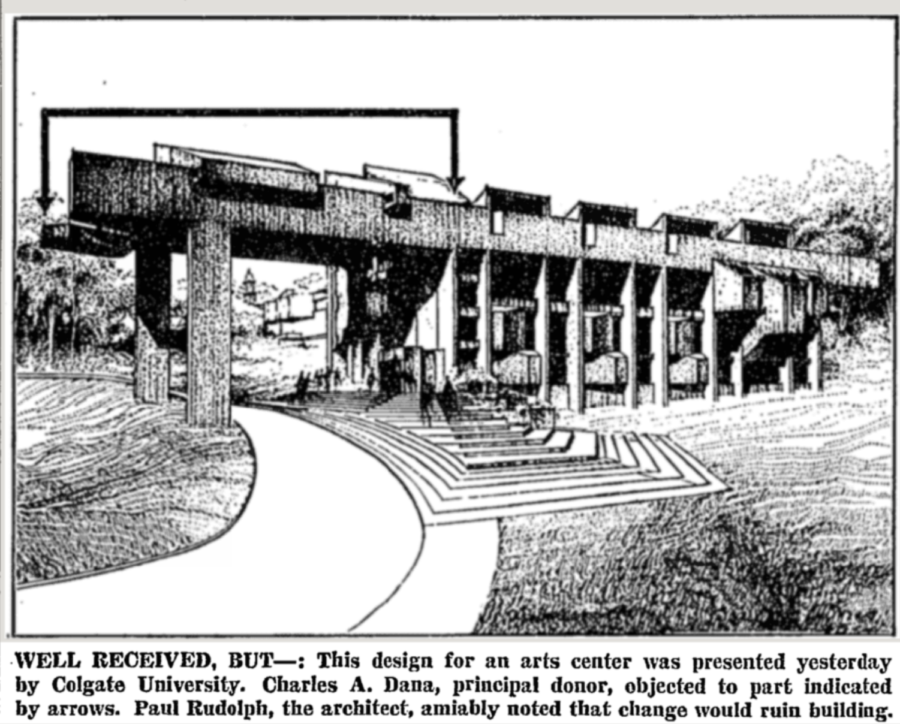

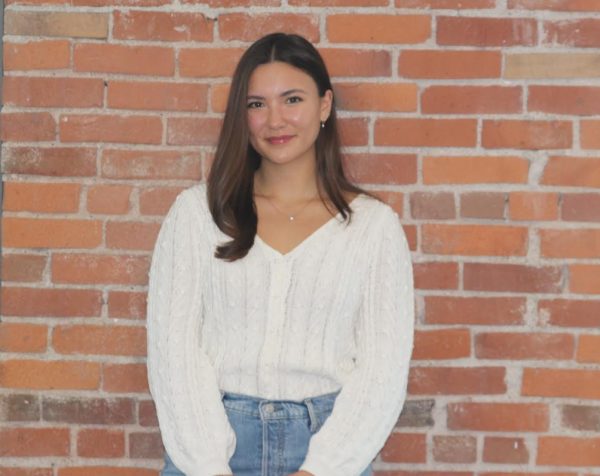
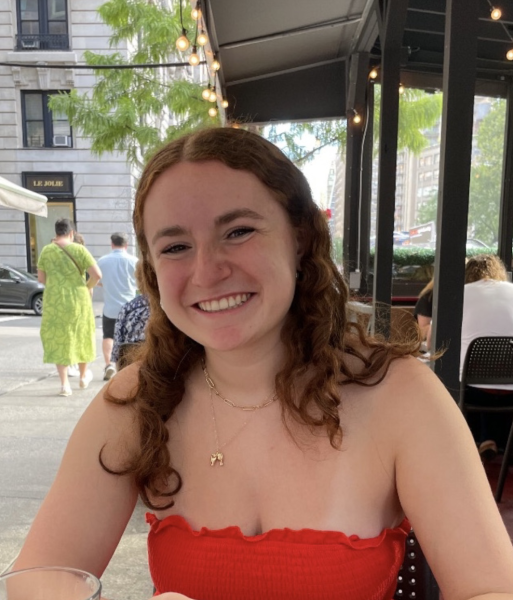





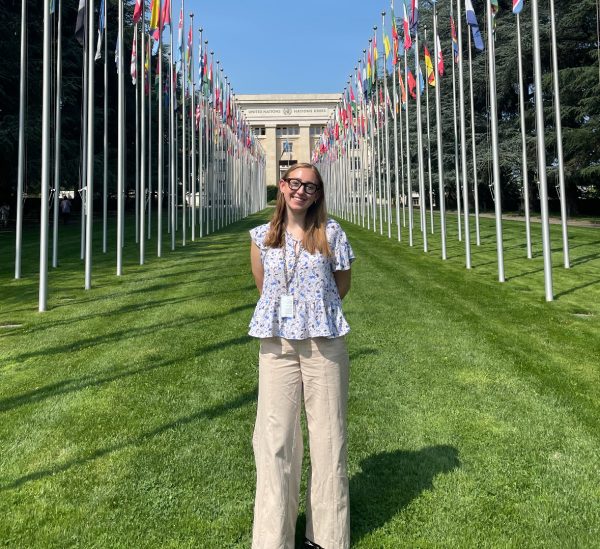
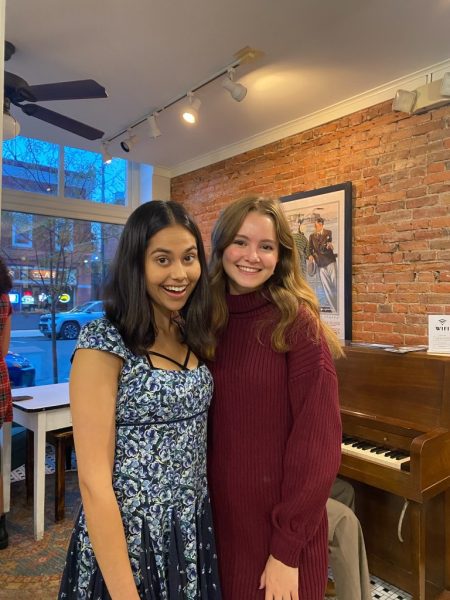



Victoria Stephens Williams • Mar 13, 2021 at 6:23 am
As a Fine Arts major at Colgate in the late 1970’s I spent much of my time in Dana. I also sang in the University Chorus and Swinging ‘Gates, so the choir room was part of my every day life. I remember that Picjer Gallery was used for rotating traveling exhibits before the per,an entry collection was housed there. Back in the 70’s it was a wonderful light-filled, dynamic space that was a different experience with each exhibit Prof. Ed Bryant curated. The bridge housed the art slide library that professors used to build their lectures. I had a job there refilling slides for a semester. Most students never got to see that space. The sculpture exhibits in the roof sculpture garden would change seasonally. The music practice rooms were open to any student. They often served as breakout rooms for the ‘Gates sectional rehearsals. You could walk by and hear the amazing piano students practicing in those spacious rooms.
One feature of Dana that was problematic was that it only had one toilet in one rest room for women. When there was an intermission during a theater presentation the lines were very long. My sophomore year I lived in Crawshaw and had a job as the breakfast checker in the dining hall in the student union. The back steps behind Dana are intentionally irregular. I learned a rhythm to get down them quickly which my muscle memory retained for a while.
One of my fondest memories of my time in Dana happened during occasional nights my freshman year. A group of us were fond of playing Sardines in Dana’s irregular nooks and crannies, which lent itself well to the game.